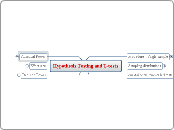Hypothesis Testing and T-tests
Decision Errors
There's an inverse relationship b/t the levels of the 2 errors
Type II
Fail to reject the null when it is false
Type I
Reject the null when its true
Effect size
Importance of:
It standardizes the difference b/t means (like a Z score) so that comparisons can be made to other scales, and even other studies (meta-analysis)
Conventions
Large = .8
Overlap of 53%
Medium = .5
Overlap of 67%
Small = .2
Overlap of 85%
Based on:
Population SD
Estimate of the sample mean
The amount that 2 populations do not overlap, or how much they are separated
Statistical Power
Power should be at least 80%
Depends on:
Significance level chose, type of test (1 or 2-tailed, etc.)
Effect size (sample size and SD)
Helps determine the real world significance of marginally significant findings
Helps determine how many participants are needed
The probability that the study will produce a significant result if H1 is true
one-tailed vs. two-tailed tests
two-tailed is non-directional
more stringent criteria
cutoff points must be cut in half
for p<.05 Z scores are +-1.96
one-tailed is directional
Sampling distributions
Confidence intervals
Results from a replicated experiment will fall in this interval 95% of the time
To find a score confidence interval, change the Z-scores to raw score by:
Multiply the SD by the Z score for each confidence interval and then add the mean
(1.96)(15)+100 = upper limit
Example: (-1.96)(15)+100 = lower limit
99% is b/t -2.57 and 2.57
95% is b/t -1.96 and 1.96
upper and lower ends are confidence limits
Based on the central limit theorem
The shape of a dist. of means is about normal if:
or the pop. distribution is normal
each sample has an N of 30 or more
The SD of a dist. of means is the sqroot of the variance of the dist of means
Also known as standard error (SE)
The variance (S^2) of a dist. of means is the S^2 of the pop divided by N
The mean of a distribution of means is the same as the mean of the population
you can figure out its characteristics by knowing:
the # of scores in each sample
the characteristics of the dist. of the pop of individuals
Shape - approximately normal
Spread - less than the spread of the real population
Mean - about the same as the mean of the real population
Procedure - Single sample
Decide weather to reject H0
Determine your sample's score on the comparison distribution
Figure the Z score for the sample's raw score based on M and SD of the comparison distribution
Determine the cutoff sample score (critical value) on the comparison distribution at which H0 should be rejected
Determine the characteristics of the comparison distribution
Subtopic
Pop Mm = Pop M
You will compare actual sample scores to the comparison distribution
Restate the question as an H1 and an H0 about the populations

